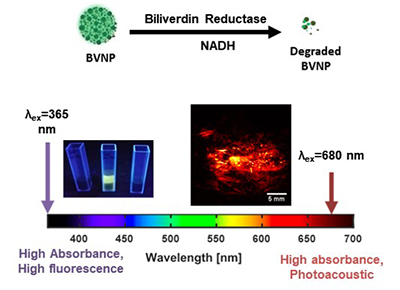"Nano-precipitation of Biliverdin Leads to Spectral Tuning of Biodegradable Nanoparticles for Efficient Photoacoustic Imaging"
Parinaz Fathi, bioengineering, Nadine Barrie Smith Fellow, National Physical Science Consortium Fellow, Bioimaging Science and Technology Group

Accumulation in the liver is one of the major barriers to the use of nanoparticles for therapeutic and imaging applications. The goal of this work was to utilize endogenous molecules to develop nanoparticles that could offer a solution to the issue of biodegradation while having strong potential for use in bioimaging applications. Biliverdin is a naturally-occurring pigment in bile that exhibits high UV-Vis absorbance in the near-IR region, providing a potential platform for photoacoustic imaging with minimal background interference from biological tissue. Biliverdin nanoparticles (BVNPs) were synthesized in a variety of solvents, and their photophysical properties were explored. The nanoparticles exhibited high absorbance at 365 nm and 680 nm, fluorescence when excited at 365 nm, and photoacoustic properties when excited at 680 nm. Nanoparticles were shown to form as early as 10 minutes into the synthesis, and their properties varied based on the synthesis solvent. BVNPs were found to be biodegradable in the presence of biliverdin reductase, a naturally occurring liver enzyme, and the application of these particles as a fluorescence and photoacoustic imaging probe was demonstrated in-vivo.
"A Locomotor Spinobot: Engineering a Functional Spinal Cord-Skeletal Muscle Bioactuator"
Collin Kaufman, neuroscience, NSF Miniature Brain Machines NRT fellowship, Cellular and Molecular Foundations of Intelligent Behavior Group

The study and production of biomimetic systems is an emerging field with a confluence of interest from areas such as tissue engineering, nanomedicine, and materials science. One of the primary focuses of this new discipline is on the development of bioactuators, systems which use or mimic biological principles to convert energy into motion. Early bioactuators have been capable of locomotor-like behavior, but lack a level of intrinsic control, thereby limiting the scope of their potential behaviors. The spinal cord is a system with known functionality and a high degree of motor complexity and by coopting these preexisting motor circuits for use with bioactuators, we are able to expedite the process of developing an autonomous biomachine while also providing a high ceiling of behavioral complexity. After demonstrating that spinal cord explants extend a robust and complex arbor of motor neurons and glia in vitro, we successfully innervated a muscular soft robot with an intact lumbar spinal cord segment which galvanized the formation of neuromuscular junctions. The newly innervated muscles initially demonstrate spontaneous contractions, which can be chemically modulated by applying drugs of interest to the spinal cord. This engineered, multicellular tissue is a key step towards autonomous soft robots capable of increasingly complex and directed behaviors. The high degree of customization inherent to this platform provides the potential for applications from traversing terrain unsafe for more traditional robots to being used as a novel tool for investigating neurodegenerative disease.
"Simulating Long Timescale Phenomena of Materials with Energy Landscape Sampling Methods"
Nathan Walter; nuclear, plasma, and radiological engineering; Computational Molecular Science Group

The long timescale dynamics of material systems, such as protein folding or phase behavior, often requires the crossing of large energy barriers by thermal activation. These energy barriers represent transition states separating two metastable states of a system. However, barrier-crossing events are challenging to simulate using conventional computational tools for atomistic simulation, such as molecular dynamics or Monte Carlo. Therefore, we propose a new method, variable steepness ascent dynamics (VariSAD), to simulate the escape of a system from a metastable state to a transition state. The method is based on the energy landscape formulation. On the energy landscape, a system is trapped in an attractive basin or metastable state. If the landscape is inverted to the “upside-down world”, the system then exists in an activated state. Energy minimization in the “upside-down world” evolves the system to an attractive basin of the “upside-down landscape.” On the original energy landscape, however, the system now exists in a transition state. Energy minimization on the energy landscape results in a barrier-crossing event traditionally difficult to simulate. By repeating these steps, VariSAD is an effective method to sample an ensemble of transition states. While the concept of VariSAD is simple, the implementation is heavily nuanced when applied to a real system. The utility of the method is demonstrated lastly with a simple 2-D polydisperse system in a highly jammed state.